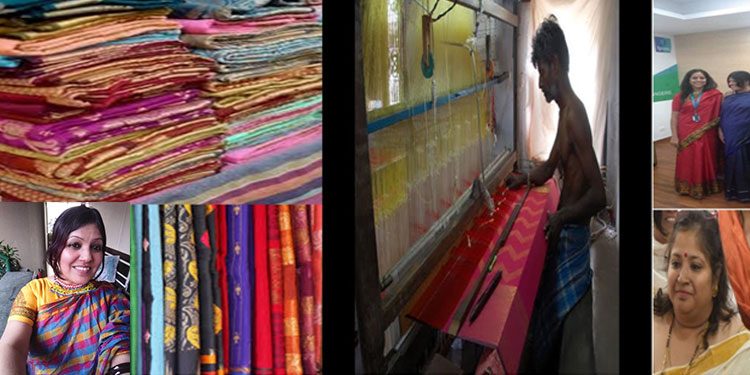In the quest for rescripting, owning and flaunting Nationalism, how about extending it to include a piece of clothing, that has been the nonpareil identity of the Indian woman – the sari – and resurrecting it to its halcyon glory?
Saga retold
Sari, the ubiquitous Indian drape has found favour with different regions all through the history.
Going back in history, into the holy scriptures, Hindu Goddesses have been resplendent, adorning the 6-yard drape, with great detailing of sequins, gold border and in the finest fabrics of silk, damaskor brocade.
Amar Chitra Katha franchise should be credited for jazzing up the goddesses, queens and princesses in their comic books,aiding in conjuring up images as they looked divine in saris, bedecked head to toe in gold jewellery. Some of the weddings of today are truly inspired by these comic books, which brought out the true beauty of Indian women. And sari of course was a key aspect of the celestial Indian woman.
I have vivid memories of reading the stories of King Nala and his beautiful consort, Damyanti. Or King Siddhartha who left his demure wife, in search of salvation. These women epitomized true Indian beauty.
Mesmerizing weaves
Sari aficionados have a knack of identifying saris by regional specialties – for them it is not just about cotton, chiffon, silk, crepe, taffeta or polyester – the connoisseurs have this list on their fingertips – patola, ajrakh, chikankari, kantha work, banarasi, mekhela, pochampally, kotpad, bandhani, leheriya, kalamkari, kota, paithani and know when these saris should be best worn – by seasons and occasions.
Losing relevance? Yes and No
Over the years, the sari has receded to the closets, albeit being pulled out largely to suit occasions – festivals, weddings, formal functions, et al. Even the national carrier has booted out the national costume. Most airlines have switched to western formal dress code or fusion wear, to add some bit of local blend to the prescribed dress codes.
Nonetheless, some industries and departments should be lauded for continuing to accord the apex status to the garment, the humble sari. The hospitality industry, esp. the luxury hotels, government departments (women babus/ civil servants) and the defence services (formal get togethers warrant women to wear saris).
The sari continues to occupy the cult status. If worn, it is always worn right, consciously, accompanying some bit of drama. With matching bodice (blouse or blouson) and a petticoat. The finicky type will never wear a sari without the fall (strip of cloth sewn to the hem of the sari to promote longevity of the garment) or without the pico of the outer end of the drape and accessorizing.
Cumbersome choice
Has the sari found disfavor with the modern woman?
Not quite.
It is perceived to be a time-consuming outfit – given its intricacies of draping– the multi-tasking woman who is constantly strapped for time, chooses easy alternatives. Kurtas and palazzos or pants are invading everyone’s wardrobes (salwars and churidars again are losing their steam). It also restricts the pace of work, given its volume and complex handling.
Perceptions have led to negative connotations
Sari clad women have easily been tagged ‘aunty’ types. Ergo, it has been thumbs down to the drapes, to offset older tagging.
Way forward
Revival of the national costume is paramount in sustaining the art form. Every step counts:
- Corporate world per se could encourage staff to incorporate saris in their daily formal wear.
- Advertising community could give the 6-yard drape a modern spin and show more contemporary women choosing saris over other attires in their adverts and campaigns.
- Government could take concrete steps to save the different unique forms of sari making expertise, by helping the weavers find continuous offtake and keen buyers.
- Brand ambassadors promoting the national costume
- National Sari Daywith buzz on social media
- The local women are preserving the traditional weaves in every state of India. We need to promote them as a part of the Tourism drive.
I plan to be the unofficial promoter of our traditional costume in 2020! Will you all contemporary women don the role of the sari promoter too?
Authored Article by Madhurima Bhatia, Content & Media Relations Lead, Ipsos India
















